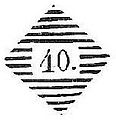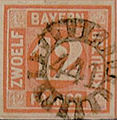Number stamp
Number stamp is a collective term for postmarks , which instead of place names and date only show a centered number and (in contrast to so-called subsidiary stamps ) were used to cancel the postage stamps . The numbers usually stood for a specific post office .
The stamps are further subdivided according to their shape into grid number stamps, rust number stamps , ring number stamps, line number stamps, mill wheel stamps , three-ring stamps , four-ring stamps , etc. Such number stamps were used in various old German states in the second half of the 19th century. At the Badische Post z. B. the five-ring and clock wheel stamps, open and closed mill wheel stamps at the Bavarian Post , grate stamps or bar stamps at the Braunschweigische Post , four-ring stamps at the Prussian Post , grid stamps at the Saxon Post , and the Schleswig-Holstein PostRust stamps and Danish three-ring stamps, and the Thurn-und-Taxis-Post office also used three- and four-ring stamps. Number stamps (mill wheel stamps) were used on a trial basis at the Württembergische Post .
Number stamps were also used in other European countries in the 19th century, for example in Belgium, Denmark, Finland, France, Greece, Great Britain, Italy, the Netherlands, Norway, Poland, Portugal, Russia and Spain (with district numbers).
Number stamps were usually superseded by place and date stamps in the 19th century, making corresponding secondary stamps superfluous. Iceland was the last European country to use number stamps from 1903 to 1930.
literature
- Peter Feuser: The number stamps of the old German states , 2nd edition, Verlag Peter Feuser, Stuttgart 2007, ISBN 3-927483-21-4
- Wolfram Grallert and Waldemar Gruschke: Transpress Lexicon Philately. Transpress VEB Verlag for Transport, Berlin, 5th edition (1981)



